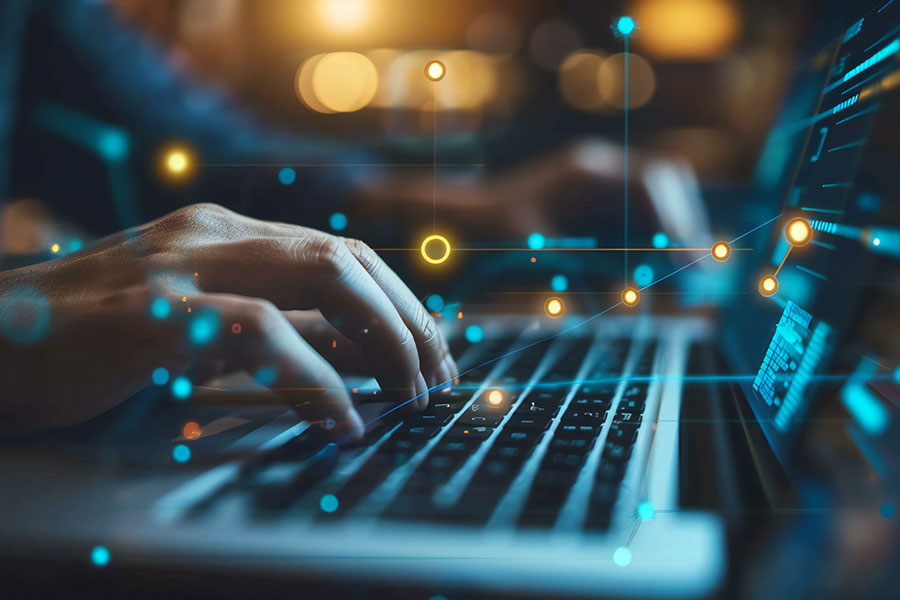How is AI changing the workplace?
Uncover the ways AI is revolutionizing the workplace. From productivity gains to cultural shifts, find out how to adapt and thrive in this new era.


The workplace is changing fast, thanks to artificial intelligence (AI). Companies across industries are adopting these smart tools to boost productivity, cut costs, and stay competitive. As AI becomes more common, it’s essential to understand how it impacts jobs, culture, and daily work routines.
Let’s assess how AI is shaping the modern workplace - what's happening, what to watch out for, and how to prepare for the future.
The workplace is changing fast, thanks to artificial intelligence (AI). Companies across industries are adopting these smart tools to boost productivity, cut costs, and stay competitive. As AI becomes more common, it’s essential to understand how it impacts jobs, culture, and daily work routines.
Let’s assess how AI is shaping the modern workplace - what's happening, what to watch out for, and how to prepare for the future.
The rise of AI in the modern workplace
Today, companies around the world are increasing their use of AI tools daily. Studies show that 78% of businesses use AI in some form, from chatbots to data analysis. This number is predicted to keep climbing fast, with AI expected to add trillions to the global economy. As AI tools become cheaper and easier to use, more organizations see them as essential for growth.
Many industries are taking advantage of AI in different ways. Healthcare uses AI to diagnose illnesses faster. Banks use it to detect fraud and approve loans more securely. Manufacturing employs AI-powered robots to speed up production. Retailers rely on AI to recommend products and optimize supply chains.
Now, the main reasons companies turn to AI include advancements in machine learning and data analytics. These technologies help businesses make better choices, faster. Reducing costs and improving efficiency also motivate AI adoption. Companies see AI as a way to stay ahead in competitive markets.
How AI is reshaping job roles and responsibilities
AI is taking over many ‘boring’ jobs, like data entry or customer support. Chatbots answer common questions, freeing up staff for more complex work. Automated systems also handle inventory management or scheduling. This leads to faster service, fewer mistakes, and better use of human talent.
Although AI replaces some tasks, it also creates new roles. We now see jobs like AI specialists, data scientists, and robot trainers appear everywhere. These jobs require new skills, creating chances for workers to learn and grow. Reskilling programs become vital as roles shift with technology.
AI tools help managers make smarter choices. Predictive analytics forecast trends, so companies plan better. In finance, AI assesses risk more accurately. Marketers use AI to target customers more precisely. HR teams rely on AI for fairer hiring processes and employee insights. Artificial intelligence acts as an augmented partner in decision-making, making organizations more agile.
Impacts of AI on workplace culture and employee experience
AI-driven tools are changing how teams communicate and work together. Project management apps with AI features help assign tasks and track progress. Virtual collaboration platforms now include AI-powered chatbots that assist with scheduling or answering questions. These tools make remote work smoother and more coordinated.
Not only that, AI can help monitor workloads and prevent burnout. For example, some organizations use AI to analyze employee stress levels or excessive overtime. Artificial intelligence can send alerts and suggest breaks. However, honesty is needed, as AI surveillance raises privacy debates. Balancing tech benefits with privacy rights is crucial.
Furthermore, AI can promote fairness in hiring by reducing human bias. Automated screening tools may identify qualified candidates who might otherwise be overlooked, thereby enhancing diversity and inclusion. However, algorithms aren’t perfect, as they can embed biases if not checked carefully. Transparency and fairness must stay top priorities.
Challenges and risks associated with AI in the workplace
Using AI raises ethical questions about data security and privacy. Companies collect a lot of personal information, and misuse can lead to trust issues. Employee monitoring, if overdone, can feel invasive. As a result, striking a balance between innovation and respecting individual rights is essential.
Similarly, AI might replace many jobs, especially repetitive or manual roles. This could widen the gap between those who have new skills and those left behind. To avoid social issues, companies and governments need plans for training workers and providing safety nets. Without action, economic inequality could grow worse.
AI systems can also make mistakes or show biases based on their data. These errors might lead to unfair treatment or poor decisions. Transparency in how AI works, coupled with human oversight, reduce these risks. Carefully testing AI for reliability before deployment is key.
Preparing for the future: strategies for organizations and employees
It’s vital to note that AI should work alongside humans, not replace them. After all, the goal is to use technology to enhance human skills and creativity. Cultures that embrace change and learning will adapt faster. Building a supportive environment helps teams stay open and resilient.
Investing in employee training is another must. Offering courses in data analysis, AI management, or digital skills helps workers stay relevant. Partnering with local schools and colleges can create new learning pathways. The more organizations commit to continuous learning and reskilling, the better they’ll adjust.
Finally, clear guidelines for AI use protect employees and maintain trust. Companies should involve stakeholders when creating policies. Ethical frameworks ensure AI is used responsibly, avoiding unfair practices. Good governance helps build confidence in AI systems.
Plan for ongoing change
AI is changing how we work in many ways. It increases efficiency, creates new jobs, and improves workplace culture. However, it also brings challenges like job loss and ethical questions. To succeed, organizations need to plan carefully. They must focus on human skills, stay ethical, and prepare their teams for ongoing change.
Embracing AI responsibly can lead to a future where technology and people grow together.
The workplace is changing fast, thanks to artificial intelligence (AI). Companies across industries are adopting these smart tools to boost productivity, cut costs, and stay competitive. As AI becomes more common, it’s essential to understand how it impacts jobs, culture, and daily work routines.
Let’s assess how AI is shaping the modern workplace - what's happening, what to watch out for, and how to prepare for the future.
The rise of AI in the modern workplace
Today, companies around the world are increasing their use of AI tools daily. Studies show that 78% of businesses use AI in some form, from chatbots to data analysis. This number is predicted to keep climbing fast, with AI expected to add trillions to the global economy. As AI tools become cheaper and easier to use, more organizations see them as essential for growth.
Many industries are taking advantage of AI in different ways. Healthcare uses AI to diagnose illnesses faster. Banks use it to detect fraud and approve loans more securely. Manufacturing employs AI-powered robots to speed up production. Retailers rely on AI to recommend products and optimize supply chains.
Now, the main reasons companies turn to AI include advancements in machine learning and data analytics. These technologies help businesses make better choices, faster. Reducing costs and improving efficiency also motivate AI adoption. Companies see AI as a way to stay ahead in competitive markets.
How AI is reshaping job roles and responsibilities
AI is taking over many ‘boring’ jobs, like data entry or customer support. Chatbots answer common questions, freeing up staff for more complex work. Automated systems also handle inventory management or scheduling. This leads to faster service, fewer mistakes, and better use of human talent.
Although AI replaces some tasks, it also creates new roles. We now see jobs like AI specialists, data scientists, and robot trainers appear everywhere. These jobs require new skills, creating chances for workers to learn and grow. Reskilling programs become vital as roles shift with technology.
AI tools help managers make smarter choices. Predictive analytics forecast trends, so companies plan better. In finance, AI assesses risk more accurately. Marketers use AI to target customers more precisely. HR teams rely on AI for fairer hiring processes and employee insights. Artificial intelligence acts as an augmented partner in decision-making, making organizations more agile.
Impacts of AI on workplace culture and employee experience
AI-driven tools are changing how teams communicate and work together. Project management apps with AI features help assign tasks and track progress. Virtual collaboration platforms now include AI-powered chatbots that assist with scheduling or answering questions. These tools make remote work smoother and more coordinated.
Not only that, AI can help monitor workloads and prevent burnout. For example, some organizations use AI to analyze employee stress levels or excessive overtime. Artificial intelligence can send alerts and suggest breaks. However, honesty is needed, as AI surveillance raises privacy debates. Balancing tech benefits with privacy rights is crucial.
Furthermore, AI can promote fairness in hiring by reducing human bias. Automated screening tools may identify qualified candidates who might otherwise be overlooked, thereby enhancing diversity and inclusion. However, algorithms aren’t perfect, as they can embed biases if not checked carefully. Transparency and fairness must stay top priorities.
Challenges and risks associated with AI in the workplace
Using AI raises ethical questions about data security and privacy. Companies collect a lot of personal information, and misuse can lead to trust issues. Employee monitoring, if overdone, can feel invasive. As a result, striking a balance between innovation and respecting individual rights is essential.
Similarly, AI might replace many jobs, especially repetitive or manual roles. This could widen the gap between those who have new skills and those left behind. To avoid social issues, companies and governments need plans for training workers and providing safety nets. Without action, economic inequality could grow worse.
AI systems can also make mistakes or show biases based on their data. These errors might lead to unfair treatment or poor decisions. Transparency in how AI works, coupled with human oversight, reduce these risks. Carefully testing AI for reliability before deployment is key.
Preparing for the future: strategies for organizations and employees
It’s vital to note that AI should work alongside humans, not replace them. After all, the goal is to use technology to enhance human skills and creativity. Cultures that embrace change and learning will adapt faster. Building a supportive environment helps teams stay open and resilient.
Investing in employee training is another must. Offering courses in data analysis, AI management, or digital skills helps workers stay relevant. Partnering with local schools and colleges can create new learning pathways. The more organizations commit to continuous learning and reskilling, the better they’ll adjust.
Finally, clear guidelines for AI use protect employees and maintain trust. Companies should involve stakeholders when creating policies. Ethical frameworks ensure AI is used responsibly, avoiding unfair practices. Good governance helps build confidence in AI systems.
Plan for ongoing change
AI is changing how we work in many ways. It increases efficiency, creates new jobs, and improves workplace culture. However, it also brings challenges like job loss and ethical questions. To succeed, organizations need to plan carefully. They must focus on human skills, stay ethical, and prepare their teams for ongoing change.
Embracing AI responsibly can lead to a future where technology and people grow together.




